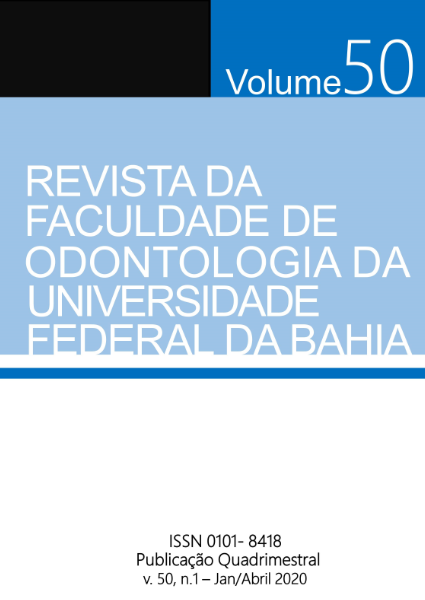APLICAÇÃO DA FIBRINA RICA EM PLAQUETAS EM CIRURGIA DE TERCEIROS MOLARES: AVALIAÇÃO DO SANGRAMENTO (PARTE I) APPLICATION OF PLATELET-RICH FIBRIN ON THIRD MOLAR SURGERY: EVALUATION OF THE BLEEDING (PART I)
DOI:
https://doi.org/10.9771/revfo.v50i1.37110Palavras-chave:
Fibrina rica em plaquetas, Hemorragia, Dente Serotino, Platelet-rich Fibrin, Hemorrhage, Molar, thirdResumo
Objetivo: Avaliar os efeitos da aplicação do coágulo leucoplaquetário
na redução do sangramento após exodontias de terceiros molares mandibulares.
Materiais e métodos: Foram incluídos na pesquisa pacientes
saudáveis, não gestantes, entre 18 e 60 anos com indicação de extração
bilateral dos terceiros molares inferiores. Os pacientes foram conduzidos
para a coleta de sangue, seguida da centrifugação e obtenção do coágulo
leucoplaquetário. Na sequência, procedeu-se o sorteio do lado a ser operado.
Em seguida, definiu-se o grupo teste onde, após a extração, houve
a colocação do coágulo e posterior síntese cirúrgica. O grupo controle
correspondeu ao lado contralateral e não se utilizou o referido coágulo,
apenas a síntese cirúrgica. Resultados: Foram avaliados doze sítios cirúrgicos,
em seis pacientes, três do sexo feminino e três do sexo masculino.
Após análise estatística com o teste do Qui-quadrado, comparativamente,
entre os grupos teste e controle, para os três períodos pós-operatórios,
não houve relevância estatística (p=0,65) com relação ao efeito do
coágulo leucoplaquetário na diminuição do sangramento. Conclusão: O
coágulo leucoplaquetário não se mostrou estatisticamente relevante na
diminuição do sangramento pós-operatório de cirurgias de terceiros molares
mandibulares para os períodos avaliados.
Purpose: To evaluate the effects of the application of the leucoplaquetary
clot in the reduction of bleeding after mandibular third molar extractions.
Methods: The patients included were healthy, non-pregnant patients, between
18 and 60 years old with indication of bilateral extraction of the
lower third molars. The patients were taken to the blood harvesting, followed
by the centrifugation and the obtainment of the leucoplaquetary
clot. Subsequently, the lot was drawn on the side to be operated. Then, the
test group was defined, on which, after the extraction, the clot was placed
and surgical synthesis was performed. The control group, corresponded
to the opposite site and in the referred site the clot was not placed,
therefor it was only sutured. Results: Twelve surgical sites, in six patients
were evaluated, three females and three males, and, after statistical analysis
with the Chi-square test, comparatively, between the test and control
groups, for the three post-operative periods evaluated, there was no statistical
relevance (p=0,65) in relation to the effect of the leucoplaquetary
clot in the reduction of bleeding. Conclusions: The leucoplaquetary clot
was not statistically relevant in the reduction of postoperative bleeding
from third molar mandibular surgeries for the periods evaluated.
Downloads
Downloads
Publicado
Como Citar
Edição
Seção
Licença
Copyright (c) 2020 Revista da Faculdade de Odontologia da UFBA

Este trabalho está licenciado sob uma licença Creative Commons Attribution-NonCommercial 4.0 International License.

